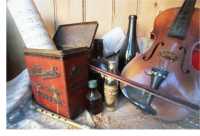Music is an integral part of Irish culture and has been as potent a force in the lives of the Irish people. The ancient Celts had an oral culture, where religion, legend, and history were passed from one generation to the next by way of epic poems, stories and songs. The closest Ireland has come to a national composer is Turlough O'Carolan. O’Carolan was a blind harpist and poet who was born in 1670. He transversed the country and wrote reels, airs and odes to men and women that are considered to be canonical Irish music, and was considered an innovator in that he wrote his music first and then added lyrics. Over 200 of his songs survive and Ireland hosts an annual harp festival in his honor.
After being conquered by the English, and forbidden to speak their own language, the Irish turned to music to help them remember important events and hold on to their heritage and history. “Rebel Music” has existed for as long as the conflicts in Ireland have existed. Various rebellions have inspired story songs recounting the lives of individual fighters, such as Sean South of Garryowen or Roddy McCorley, were used to rouse passions and are still sung today.
As serious and heartfelt as such music can be, there is as vital a traditional of street ballads, popular songs with lighter themes. “Molly Malone” from the 1750’s is the story of a comely fishmonger who died and whose ghost is said to haunt the market. The song is considered the unofficial anthem of the city of Dublin, and a statue of the girl was erected to celebrate Dublin’s Millennium. “Finnegan’s Wake,” a comic story song about a man who died in an accident but was revived when one of the brawlers at his wake accidentally spilled whiskey on the corpse. The song has been perennially popular and also inspired James Joyce’s notoriously difficult masterpiece, Finnegans Wake. Many street ballads are devoted to tales of drinking, and these, too, have stood the test of time. From the unrepentant declaration of “The Moonshiner,” to the winking reprobate “The Wild Rover” to the man whose faithless girlfriend convinces him that his only dependable companion is “Whiskey in the Jar,” the Irish drinking song is usually much more of a celebration than a cautionary tale. Many of these songs were introduced to a wider audience during the folk revival of the 1960’s, when Irish musicians such as the Clancy Brothers, the Chieftains and the Dubliners gained popularity throughout the world.
And Irish artists have also had a huge impact on popular music beyond the traditional. In the latter half of the 20th century, the Irish proved themselves to be anyone’s equal in producing popular music. Belfast-born Van Morrison has been making compelling music in different genres for over thirty years now. The punk movement of the late 1970’s inspired as many young Irish musicians as it did English. Two bands from Northern Ireland, Stiff Little Fingers and the Undertones were enormously popular. And it was the Dublin punk scene that produced one of the best known and most beloved of Irish musical exports—U2. The Cranberries and the Corrs have also had huge international success with their gentler pop music.
Several groups have achieved success by combining traditional elements with modern styles to revitalize Irish music and introduce it to new audiences. Glam rock’s Thin Lizzy first found success came with a metal version of the standard “Whisky in the Jar,” and the London-based Pogues, made up of 1st-generation and immigrant musicians arranged traditional songs in a punk style that garnered huge popularity. New age musicians have also found inspiration in Ireland’s traditions, notably Enya, who is the most successful female artist in Irish history.
The diversity of styles and tastes means that there is something for everyone to be found in Irish music. And whether artists are charting new territories or keeping traditions alive, music will continue to be a vital part of Irish culture
